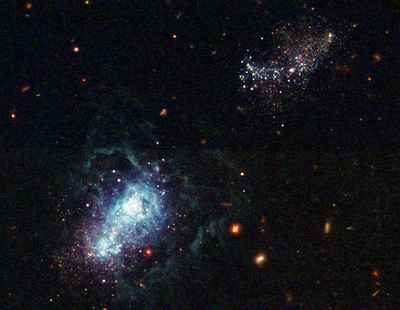Yael Petar

Astronomers don't know what it is, but every now and then they find more evidence for the existence of dark matter and reveal new layers about the mysterious substance.
A new project using old images from the Hubble Space Telescope has mapped the invisible dark matter in an unprecedented way. The researchers focused on two galaxy clusters that are so far away that the light from them takes so long to reach that it seems they existed when the universe was still half its current age.
The observation provided additional information supporting a commonly held theory that galaxies form in cosmic webs, where ordinary matter and dark matter are concentrated into a junction, like dewdrops collected on a web of spider webs.
You can also think of it as foam that gathers at the ends of ocean waves, says Johns Hopkins University research team member James Gee.
Strange things
Researchers believe that dark matter exists because without it, galaxies would disintegrate and be thrown everywhere due to a lack of gravity. However, mapping something that cannot be seen can be problematic.
"Verifying the theoretical simulations by observation is a challenging thing, since dark matter does not produce light" says Ji.
The trick is to find a subtle distortion in the images, caused by gravitational lensing, where the shape of distant galaxies is curved due to a high concentration of matter between the galaxy and us. Although the material is not visible, it moves the light rays using its gravity, thus revealing its presence.
"The images we took clearly show that the galaxy clusters are located in a region loaded with dark matter, which are marked in purple in our images," says Ji.
The results are detailed in the "Astrophysical Journal" of December.
Dark matter makes up about 90% of the total matter in the universe. Theoretically, it should cluster together with normal matter, since their gravitational effects are mutual. The new observations support this idea, claims Ji.
The research even supports the idea that dark matter is not made of particles that can collide. We don't know if dark matter is made of particles at all, but if so, they must be non-collisionable.
"Such particles do not collide with each other, like the hydrogen atoms for example do" says Ji. "If the dark matter particles collided, we would be able to notice a more equal distribution of the dark matter, without lumpy small structures."
Both clusters each contain more than 400 galaxies.
"These images are actually mainly intended for the study of the galaxies in clusters, and not for the study of the dusting of the background galaxies," says another researcher Richard Witt from the Space Telescope Science Institute, which operates the Hubble for NASA. "But the sharpness and sensitivity of the images made them ideal for this project. This is the true beauty of the Hubble photographs: they will be used for scientific research for years to come."
For information on the Johns Hopkins University website
Yadan astrophysics 1 - the universe
https://www.hayadan.org.il/BuildaGate4/general2/data_card.php?Cat=~~~342041135~~~60&SiteName=hayadan
